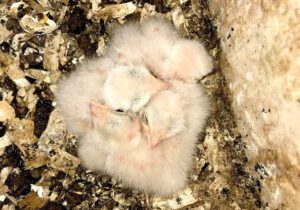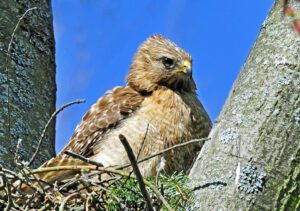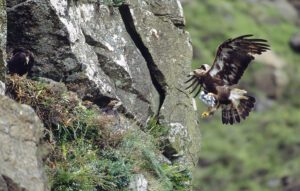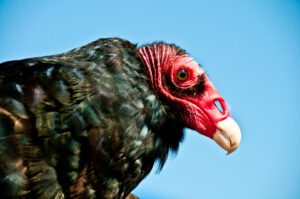
With open grasslands, towering rocky cliffs, and high peaks, Mount Diablo is a bird’s paradise. Over Mount Diablo’s cliffs and valleys, some of the most iconic North American raptors can be seen soaring through the air.
Around springtime, many raptors will be nesting and laying eggs, with chicks hatching not long after.
Next time you’re venturing into the wilderness of Mount Diablo, look up: you might see some of these magnificent birds of prey soaring overhead. And you might see some of their nests tucked away within Mount Diablo’s trees and cliffs.
Peregrine Falcons

A juvenile peregrine takes flight. Photo: Kendall Oei.
Bay Nature has called peregrine falcons “the most spectacular native ‘raptor’ of all,” but for many years peregrines weren’t even present on Mount Diablo. High DDT concentrations had caused peregrine falcons’ eggshells to thin in the 1950s, lowering survival rates and wiping out huge swaths of the population.
Peregrines are especially vulnerable to DDT because their diet mostly includes other birds, which at that time contained a high concentration of pesticides from their diets of insects and seeds.
After DDT was banned in the 1970s, the peregrine falcon population recovered and eventually returned to healthy levels.
Seth Adams, Save Mount Diablo’s first staff person, led the recovery of the Diablo region’s peregrine population. Save Mount Diablo sponsored a four-year program to reintroduce falcon chicks at several locations on the mountain starting in 1989.
After decades of work, these incredible raptors can be seen soaring above and nesting throughout the outcroppings of Castle Rock. Large parts of this scenic formation are closed from February to July every year to protect their nesting habitat.
Female peregrines usually lay two to five eggs that incubate for 29 to 32 days during this time. The young take their first flight after up to 49 days.
Peregrines need their space to successfully nest; a lot of traffic near the nests can decrease their chances of raising chicks or cause them to abandon a nest site.
Prairie Falcons

Photo: USFWS Mountain Prairie / CC BY
Prairie falcons make their home in arid areas of the west, including the Diablo Range. They hunt over the grasslands of Mount Diablo, utilizing the contours of the ground to catch their prey by surprise.
They usually lay two to six eggs, and nest on ledges or crevices of cliffs or other high places (even trees or buildings). The fledglings leave the nest about four to seven weeks after hatching.
After DDT decimated peregrine falcon populations, prairie falcon populations grew considerably, taking over the peregrines’ territory. Eventually when peregrine falcons were reintroduced to Diablo, young captive-raised peregrines were placed in the prairie falcons’ nests.
Because the prairie falcons are of a relatively similar size and appearance to the peregrines, the peregrine chicks’ new “parents” were none the wiser. They adopted these fluffy new additions to their nests as their own.
Today prairie falcons are not thriving as well as peregrine falcons in the Diablo region—so we’ll monitor their populations and consider ways to help.
American Kestrels

Kestrel eyas (nestlings) in one of Save Mount Diablo’s nest boxes. Photo: Brian Richardson
Kestrels usually like to nest within cliffsides, dead trees, and even man-made nesting boxes.
For several years, Save Mount Diablo has been supporting research about the American kestrel population on and around Mount Diablo through the installation of nest boxes with wildlife cameras.
As of 2022, we determined that up to 75 percent of our nest boxes have successfully served as kestrel habitat!
A mating pair of American kestrels generally produces four to five eggs per clutch. Taking up to 32 days to incubate, these eggs can be white, yellow, or pale brown and speckled with brown, gray, and violet-magenta. It then takes another 28 to 31 days for the fledglings to experience their first flight.
Red-Tailed Hawks

A red-tailed hawk in her nest. Photo: AcrylicArtist / CC BY
Widespread, and easily recognizable because of their reddish tails, red-tailed hawks can commonly be spotted at a distance by sharp-eyed visitors to Mount Diablo.
Red-tailed hawks like to nest in the forks of large trees 35 to 75 feet from the ground or even in cliff ledges. Their nests can usually be used for multiple years. When the time comes, female hawks typically lay one to five eggs that will take 28 to 35 days to hatch.
After hatching, the young downy chicks can remain in the nest for up to 48 days before they launch into the sky, now nearly as large as their parents.
Golden Eagles

Photo: NatureScot Images / CC BY
Did you know that the northern Diablo Range is home to the highest concentration of nesting golden eagles in the world? These large and magnificent birds, with their wingspans of six to seven feet, are a surprisingly common sight in the Diablo region!
Big birds need big nests, so these raptors are quite the builders—they construct nests that average five to six feet wide. Their nests are often made with tree branches and grass and are often used for several years, with repairs being made regularly.
Females usually lay one to three eggs that incubate for 41 to 45 days. For golden eagles, the nestling period is 45 to 81 days.
Turkey Vultures

Photo: Jerry Kirkhart / CC BY
If you’ve spent any amount of time on Mount Diablo, then you’ve probably seen turkey vultures circling overhead, on the lookout for roadkill.
They usually nest in sheltered areas, like cliffs or caves, and lay one to three whitish eggs, blotched with brown and lavender. The eggs take longer to incubate than a lot of other birds, about 28 to 40 days to hatch.
While still in the nest, the fledglings will eat food that is regurgitated into their mouths by their parents.
It takes young turkey vultures nine to 12 weeks to spread their wings and take their first flight, finally soaring into the sky.
Top photo: golden eagle chicks


